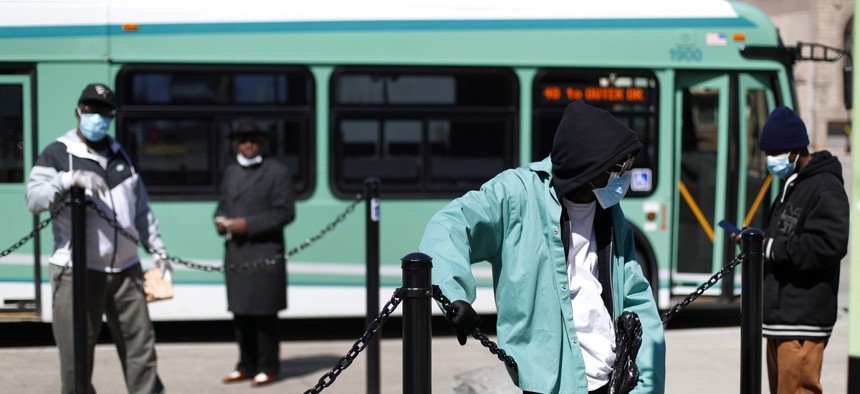The Chronic Conditions That Make Coronavirus More Deadly Are Not Equally Spread Across the U.S.

People wait for the bus in Detroit. The city, which has been a coronavirus hotspot, is also one of the top U.S. cities for rates of hypertension, a comorbidity of coronavirus. AP Photo/Paul Sancya
Pre-existing health conditions like hypertension and heart disease—which can make Covid-19 more difficult to overcome—are more prevalent in certain regions.
Over the weekend, Alex Azar, the secretary of the U.S. Department of Health and Human Services, said that the country’s death rate from coronavirus—one of the highest in the world—is due in part to people’s existing health problems. Speaking on CNN, Azar said that conditions like obesity, hypertension, and diabetes, all of which make the virus more deadly, and are more common in the U.S. than other countries, present “greater risk profiles” for the country.
“Unfortunately, the American population is very diverse, and it is a population with significant unhealthy comorbidities that do make many individuals in our communities, in particular African American minority communities, particularly at risk,” Azar said. “That is an unfortunate legacy of our health care system that we certainly do need to address.”
That legacy doesn’t affect everyone in the U.S. equally. African Americans, as Azar pointed out, are more likely to have comorbidities—a medical term to describe chronic health conditions—that result in worse outcomes for coronavirus patients, like diabetes, high blood pressure, and asthma. The same is true for Latinos. Prevalence of these conditions also cluster regionally, with disproportionately high rates in the South and Midwest. The South, for example, contains nine of the top ten states with the highest percentage of people diagnosed with hypertension (and all ten if you consider Oklahoma part of the South).
It’s not as if comorbidities flourish in humid southern climates or are determined solely by genetics—so these diseases aren’t inherent to groups in which they’re prevalent. Rather, they’re the result of multiple overlapping factors, said Tomi Akinyemiju, a professor of population health sciences at Duke University who authored a 2016 study about health condition disparities in the U.S.
“These issues cluster around the South for a lot of reasons. Access to care is lower, as many states did not do Medicaid expansion. There are also higher rates of poverty. People who have insurance may not have reliable transportation to healthcare providers or can’t afford the co-pay. That confluence turns borderline issues into chronic ones,” Akinyemiju said.
African American and Latino communities in the South and elsewhere often suffer from disinvestment, she added, meaning they might face barriers like food deserts and a lack of healthy produce options nearby, or have to deal with pollution and other environmental factors.
“When we think about comorbidities, we have to pay attention to the fact that there are individual factors, yes,” she said. “But health care needs to be a comprehensive conversation.”
To have that conversation, we need better data, Akinyemiju said. While initial reports about how Covid-19 patients with comorbidities respond to the respiratory illness have been helpful, they’ve so far been scattered. “The CDC and most states aren’t collecting individual demographic data, and that makes it really hard to track both the magnitude of the problem and the impact that statewide decisions are having,” she said. “We need more granular data.”
Medical researchers in New York City have determined that 94% of hospitalized patients had at least one comorbidity, and 88% had two or more. Preliminary data shows that conditions like hypertension, diabetes, and high cholesterol are the most common conditions among hospitalized coronavirus patients—and respiratory diseases like asthma, which many worried would put people at higher risk, are much less represented than doctors thought they would be.
Recent concerns about the health conditions that make people particularly vulnerable after getting Covid-19 has led some states to take a stronger approach to tracking them. Hospitals in Florida recently teamed up to form a joint dashboard of clinical data, including comorbidities of Covid-positive patients. Officials in Pennsylvania this week announced that they were transitioning to a new data collection system that would also track that information.
Other states have been tracking comorbidities since the beginning of the pandemic. In Illinois, state officials say the majority of people who have died from the coronavirus had at least one underlying health condition. “Almost 90% of the fatalities had an associated comorbidity,” Illinois Public Health Director Dr. Ngozi Ezike said during an update on May 6. “We’ve talked about heart disease, we’ve talked about chronic obstructive pulmonary disease, asthma, diabetes. So, there is a list of conditions which are quite common in our population.”
In New Hampshire, officials say that higher comorbidity rates among the state’s black and Latino populations have led to a growing number of serious cases in these communities. Rogers Johnson, chair of the Governor’s Council on Diversity and Inclusion told The Granite State News Collaborative that the state should be prioritizing black and Latino residents in the pandemic response in the same way they are with other at-risk populations, offering more testing and greater access to personal protective equipment.
“They need to go the step further to provide these services to the minority communities who are adversely affected by the disease,” Johnson said. In the long term, he said, the state needs to provide better economic opportunity to minorities to break cycles of inequality. “Those things take time, but we can start that process now,” he said.
Akinyemiju’s advice to leaders in areas where residents are already living with difficult health conditions is to take a “data-driven and evidence-based” response. “The understanding that people with comorbidities have higher risk needs to define how we allocate resources and design preventative efforts,” she said. “You can issue guidelines specific to the people with the highest risk. But to do that, you have to start with data.”
Emma Coleman is the assistant editor of Route Fifty.
NEXT STORY: Weddings Move Online in the Age of Coronavirus






